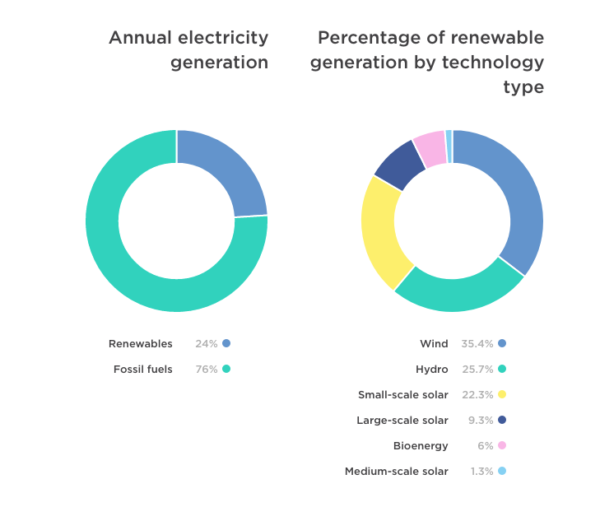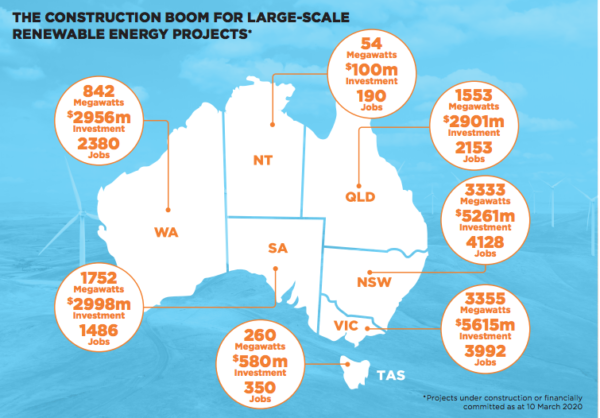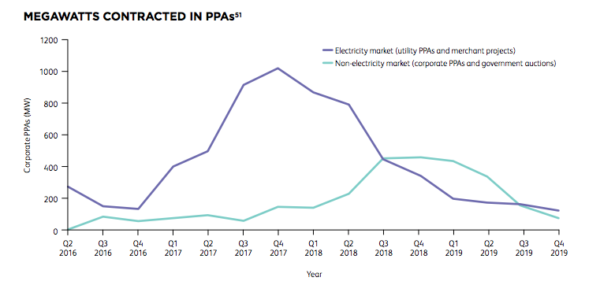Despite significant challenges facing the industry, renewables continued to smash records across the board in 2019. While rooftop PV, grid-scale solar and wind, energy storage, and hydrogen experienced remarkable growth, new large-scale renewable energy investment commitments went through a major downturn as grid woes threw sand in the gears.
According to the Clean Energy Council’s (CEC) latest edition of the Clean Energy Australia report, Australia’s large-scale renewable energy capacity increased by 2.2 GW across 34 projects in 2019, with large-scale solar making up more than two-thirds of this new capacity or a total of 1.416 MW of new capacity added across 27 solar projects. The rooftop solar juggernaut continued to thrive as 2.2 GW of installed capacity smashed the previous year’s record of 1.6 GW.

In 2019, renewable energy was responsible for 24% of Australia’s total electricity generation, an increase of 2.7% on 2018. For the first time, wind overtook hydro as Australia’s leading clean energy source with 837 MW of new capacity installed across eight new wind farms, accounting for more than 35% of Australia’s renewable energy generation. Hydro contributed 25.7%, which was less than in previous years due to the ongoing impact of the drought in eastern Australia and the massive growth experienced by wind and solar. The third biggest source of clean electricity was rooftop solar, accounting for more than 22%.
There were 287,504 rooftop solar installations in 2019, which was the most installs since 2012 and the third-highest number ever. However, the continued growth in average system size, which again increased to 7.62 kW in 2019, meant that the industry’s 2.2 GW of installed capacity was more than 35% higher than last year’s record, the report finds.
CEC Chief Executive Kane Thornton said 2.2 GW of new large-scale renewable generation capacity added to the grid and the rooftop solar industry experiencing its third-straight record-breaking year culminated in Australia achieving the Renewable Energy Target more than a year ahead of schedule.
“A record 2019 saw Australia take a major step towards a clean energy future, with 4.4 GW of renewable energy capacity installed, which is the equivalent to more than two times the capacity of the Liddell Power Station installed in just a single year,” he said.
In terms of renewable energy penetration, Tasmania led the nation with 95.6% of its electricity in 2019 provided by clean energy sources. It was followed by South Australia (52.1%), Victoria (23.9%), Western Australia (20.9%), New South Wales including the Australian Capital Territory (17.1%) and Queensland (14.1%).
Batteries, hydrogen, job bonanza
According to CEC, 2019 was a watershed year for home and grid-scale batteries. The battery storage sector started to gain momentum, with the more than 22,000 small-scale batteries installed taking Australia’s household storage capacity past 1 GWh for the first time. At the end of the year, 15 large-scale batteries were under construction.
The emerging renewable hydrogen industry enjoyed the limelight last year, with $370 million in funding allocated under the National Hydrogen Strategy and the states delivering their own hydrogen strategies and projects.
 The renewable energy industry was responsible for almost 23,000 jobs across the construction (12,202), operations and maintenance (2,537) and rooftop solar installation (8,188) sectors in 2019. At the end of the year, 11.1 GW of new generation was under construction or financially committed, representing $20.4 billion in investment and more than 14,500 jobs.
The renewable energy industry was responsible for almost 23,000 jobs across the construction (12,202), operations and maintenance (2,537) and rooftop solar installation (8,188) sectors in 2019. At the end of the year, 11.1 GW of new generation was under construction or financially committed, representing $20.4 billion in investment and more than 14,500 jobs.
Sliding confidence
While the end of year cumulative investment and capacity may seem impressive, investor confidence took a big hit in 2019. The continued lack of a federal energy policy and transmission and connection challenges, such as grid congestion, transmission loss factors (MLFs) and system strength issues, resulted in new investment commitments falling by more than 50%, from $10.7 billion in 2018 to just $4.5 billion in 2019, the report says.
With a lack of policy and significant grid constraints, corporate power purchase agreements (PPAs) slowed down in Australia bucking the global trend. There were 22 new corporate renewable PPAs announced, which contracted 400 MW of capacity and supported projects totaling 1500 MW.

“Australia’s renewable energy industry has demonstrated incredible resilience so far, but we are starting to feel the effects of a decade of political squabbling over climate change and a severe lack of planning for a 21st-century grid,” Thorton said. He added that a quick resolution was essential to ensure the industry’s momentum could be restored and Australia’s future energy supply secured.
“Our ageing coal-fired power stations are becoming increasingly unreliable, with many due to retire in the next 15 years. We have now reached a critical point where we must continue to grow our renewable energy capacity and accelerate work to upgrade our outdated grid infrastructure so that we can successfully transition to a modern, clean energy system,” he said.
As the economic fallout of Covid-19 becomes clear, the CEC continues to lobby federal, state and territory governments to ensure that renewable energy and energy storage is a key part of their pandemic response packages. “The renewable energy industry is uniquely placed to lead Australia’s recovery from the Covid-19 crisis. In addition to providing much-needed stimulus to the Australian economy, we can insulate households and businesses from high electricity costs while also ensuring that we meet our emissions reductions obligations,” he said.
Despite challenges, Thornton strongly believes the industry has a bright future. “There is still a strong pipeline of renewable energy and storage projects and enormous customer demand for rooftop solar and batteries. These will be critical in replacing Australia’s ageing coal-fired power stations, meeting Australia’s climate change targets and ensuring affordable and reliable power supply,” he said.
This content is protected by copyright and may not be reused. If you want to cooperate with us and would like to reuse some of our content, please contact: editors@pv-magazine.com.









2019 was remarkable but remains to be seen how COVID-19 will affect the renewable industry.